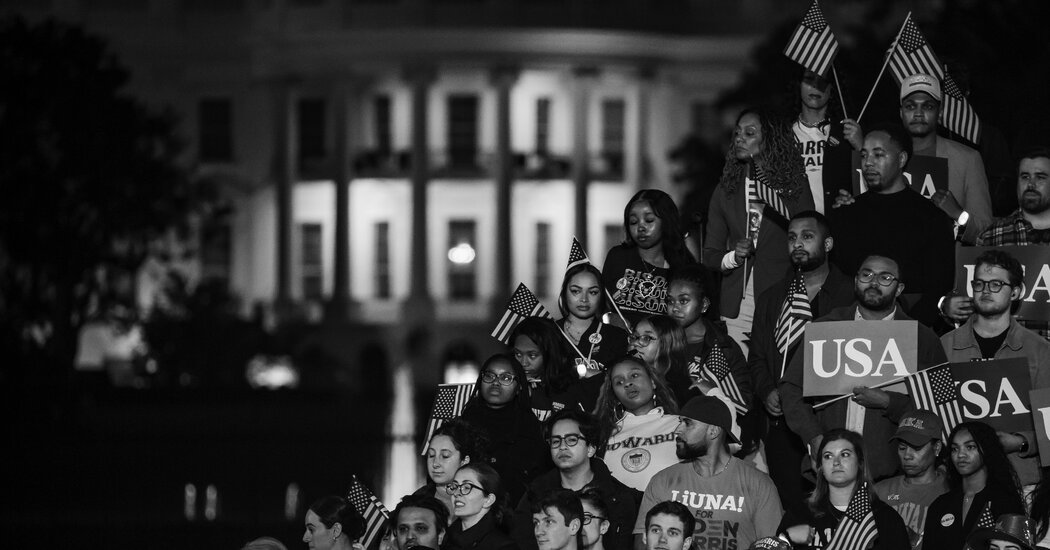Opinion | This Election Pits the Guardians Against the Counterrevolutionaries
Imagine telling yourself, in 2012, that just three presidential elections into the future Barack Obama, Dick Cheney, Arnold Schwarzenegger, Alberto Gonzales, Barbara Lee and Elizabeth Warren would be endorsing the same candidate. Such is the strange breadth of Kamala Harris’s coalition: a popular front united not by shared policy goals but by a shared defense of American institutions.
The breadth of Trump’s coalition is different: It stretches from anti-corporate naturalists like Robert F. Kennedy Jr. — who says Trump has promised him “control” of public health agencies — to post-liberal Catholics like JD Vance to crypto bros to Elon Musk. This, too, is a coalition with vast policy differences. They are united by a shared distrust in — and desire to take control of — American institutions.
We’re used to elections pitting Democrats against Republicans. This election pits Guardians against Counterrevolutionaries.
Steven Teles, a political scientist at Johns Hopkins, described it to me like this: We normally think of America as polarized across a left-right ideological divide. This was the axis of political polarization in 2012: The parties were divided on Obamacare and tax rates and austerity. Republicans said they represented America’s entrepreneurial makers against the Democratic coalition built around the indolent 47 percent who paid no income tax and lived off the government. Democrats painted Mitt Romney as a rapacious private equity firm that had taken temporary human form.
That left-right divide on economics persists: Mike Johnson, the Republican speaker of the House, just said he’d prioritize uprooting Obamacare. But it’s not the divide that matters most in this election. After all, Trump has repeatedly (and falsely) bragged on the campaign trail about saving Obamacare. Other traditional ideological divisions are more present: To the extent the election is about any one policy issue, it’s about abortion, and there the stakes are undeniable.
But there’s another axis that politics can polarize along: the basic worth of institutions. To Democrats, the institutions that govern American life, though flawed and sometimes captured by moneyed interests, are fundamentally trustworthy. They are repositories of knowledge and expertise, staffed by people who do the best work they can, and they need to be protected and preserved.
The Trumpist coalition sees something quite different: an archipelago of interconnected strongholds of leftist power that stretch from the government to the universities to the media and, increasingly, big business and even the military. This network is sometimes called the Cathedral and sometimes called the Regime; Trump refers to part of it as the Deep State, Vivek Ramaswamy calls the corporate side “Woke Inc.” and JD Vance has described it as a grave threat to democracy.
This is not a unified critique. Trump’s evangelical supporters see institutions dominated by the godless discriminating against their way of life. Elon Musk bought Twitter because he thought it had become a vector for the “woke mind virus” that had infected his children and was snuffing out free speech. R.F.K. Jr. spreads conspiracy theories about vaccines and frets over food additives (which makes for an odd alliance with Trump, a man made of Big Macs and Diet Coke who presided over the Covid vaccine project Operation Warp Speed). There is no singular set of policy changes that would satisfy these figures and many that would divide them. This is a bid for control of the commanding institutions of American life, not for reform.
“Go back to McCain-Romney era,” Patrick Ruffini, the co-founder of Echelon Insights, a Republican polling firm, said. “There was a sense that the elections then were about basically earning the right to run the system. We were going to have our attendant think tanks and internal institutions that’ll be elected as guardians of what the system is. That’s been thrown out.”
In that sense, the Trumpist coalition isn’t conservative at all. It’s counterrevolutionary. It believes a leftist revolution has corrupted American institutions, and a counterrevolution — which may even require violence — is necessary. I think a lot about something that Kevin Roberts, president of the Heritage Foundation, which oversaw Project 2025, told Steve Bannon’s “War Room”: “We are in the process of the second American Revolution, which will remain bloodless if the left allows it to be.”
In 2024, Pew polled Democrats and Republicans on their views of various government agencies. The net favorability gap between Democrats and Republicans on the Centers for Disease Control and Prevention was a stunning 92 points; on the Environmental Protection Agency, it was 80 points; on the Department of Education, it was 73 points. Fine, all those are liberal-coded agencies. But it keeps going: a 62-point gap for the F.B.I., a 60-point difference on the Department of Transportation; a 37-point gap on the Department of Homeland Security. In all of these cases — yes, even the Department of Homeland Security — it was Democrats reporting far more favorable feelings.
It wasn’t always this way. In 1970, Democrats and Republicans were nearly equally likely to trust the media (74 percent and 68 percent). Now 54 percent of Democrats trust the media but only 12 percent of Republicans do. Republicans are turning against institutions they had more trust in until recently. In 2019, 54 percent of Republicans, but only 23 percent of Democrats, said big corporations had a positive impact on American life. By 2022, that had fallen to 26 percent of Republicans, and risen ever so slightly to 25 percent of Democrats.
Fully diagnosing these trends is beyond what I can do in this column. Suffice it to say that there is no one cause, and the many causes that do exist feed off one another. Part of it reflects the Democratic Party’s increasing strength among highly educated voters, which has led them to dominate institutions that prize elite credentials; part of it reflects a long-running conservative effort to delegitimize academia and the media and the government, which has led to fewer Republicans seeking careers in those institutions; part of it reflects the behavior of Donald Trump, which was and is so extreme that institutions have been forced into responses that have enraged his supporters, ranging from his 2021 ban from major social media platforms to the criminal prosecutions against him.
You might assume that this realignment would push Democrats, at least, toward a less progressive economic agenda. But that’s not the case: Democrats are well to the left of where they were in the Clinton or Obama years, even as their coalition is more affluent now. This reflects richer Americans adopting more liberal views as they assimilate into the Democratic coalition.
“The very richest Democrats have become just as left-wing on economics as their less affluent party members, and far more economically progressive than low- and middle-income Republicans,” Rogé Karma writes in The Atlantic. “U.S. politics seems to have decisively entered what you might call a post-Marxist or post-materialist phase.”
Some of this reflects Donald Trump scrambling the system’s litmus tests. You could not be a Republican in good standing in 2012 and support the Affordable Care Act or raising taxes on the rich. With very rare exceptions, you cannot be a Republican in good standing in 2024 and forthrightly say that Donald Trump lost the election or that the insurrection of Jan. 6 was heinous. Democrats have shifted their policies less spectacularly, but the ease with which Harris walked back the most progressive positions she took in 2019 reflects a similar dynamic: What matters most, now, is protecting the system from its enemies.
But here, too, we see a feedback loop emerging. A survey by the Center for Working Class Politics and YouGov tested a number of messages among working- class Pennsylvanians and found that none performed worse, for Democrats, than focusing on the threat Trump poses to democracy. At least in that survey, those voters wanted to hear how Harris would curb the power of billionaires, not how she’d protect the integrity of a government they mistrust.
Surveys like that should be treated with some skepticism. The Harris team is running plenty of its own polls and focus groups and message tests. Still, it was striking to see Harris delivering her closing argument in Washington at the site Trump used to incite the mob that stormed the Capitol. Her speech had plenty to say about the economy, but the visual made the stakes of the election perfectly clear: one party promising to defend America’s institutions against the other party, which seeks to conquer them.

